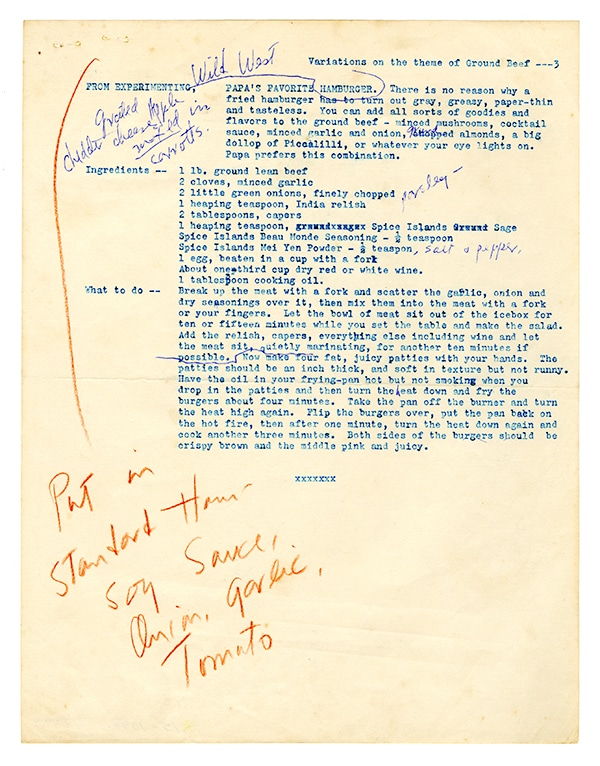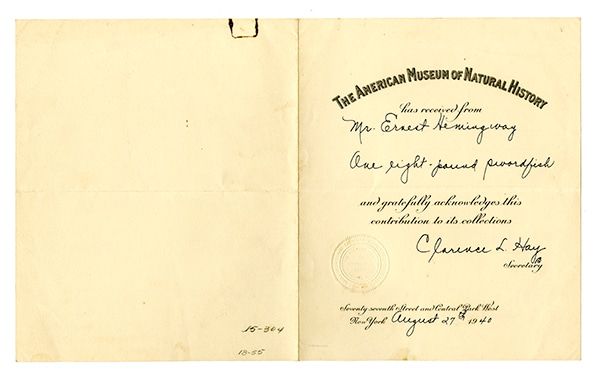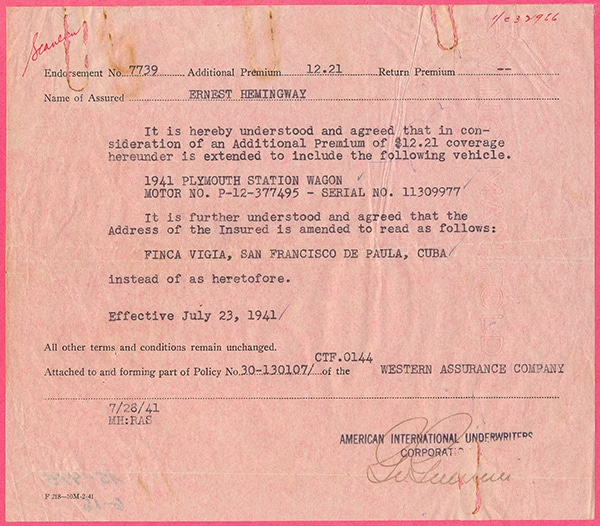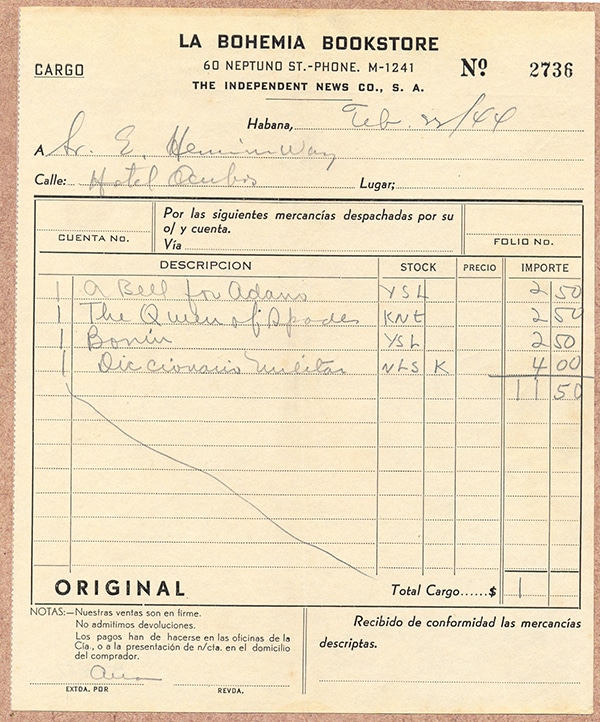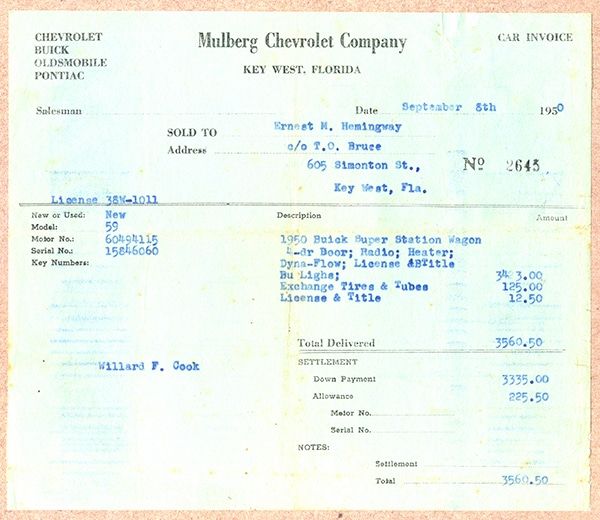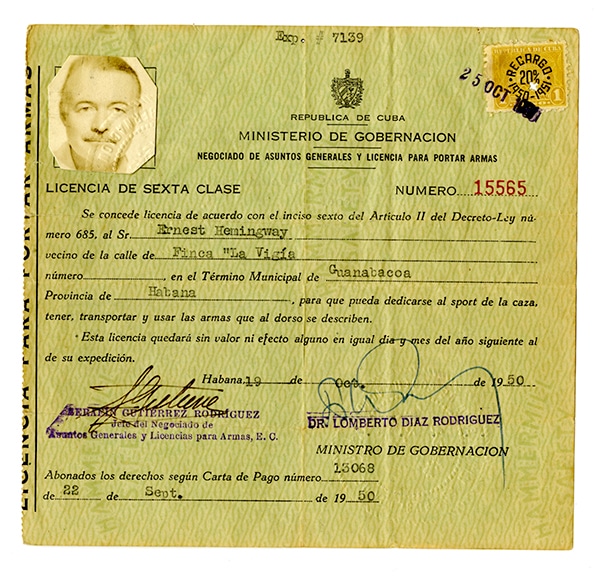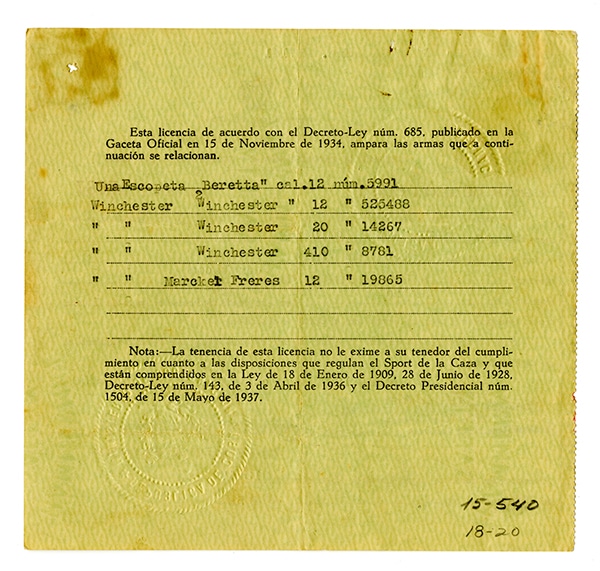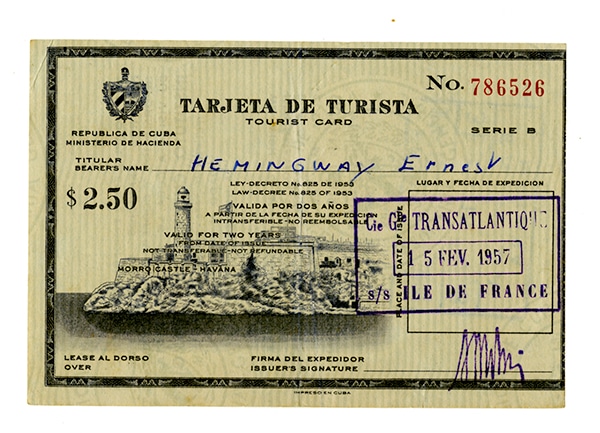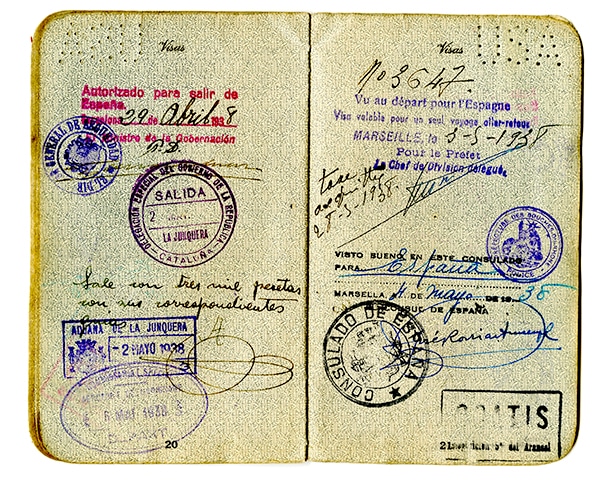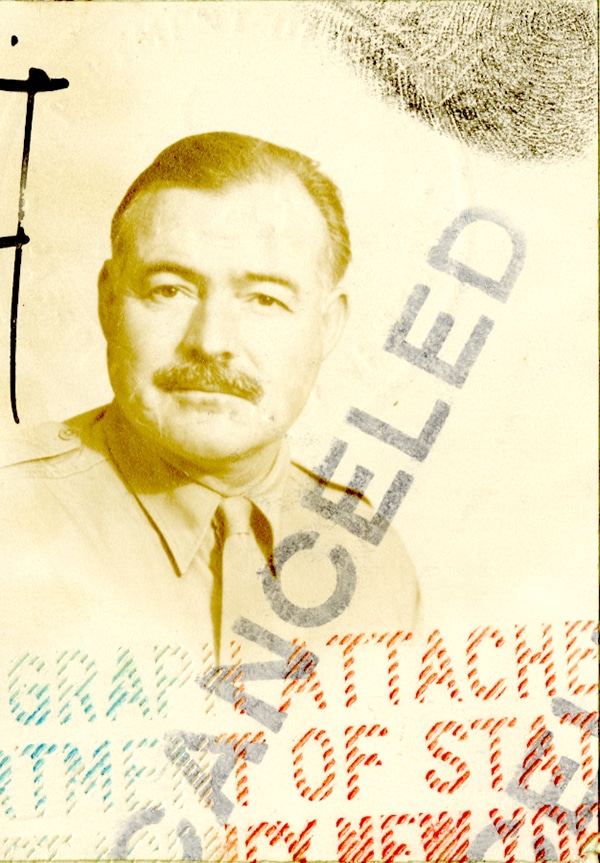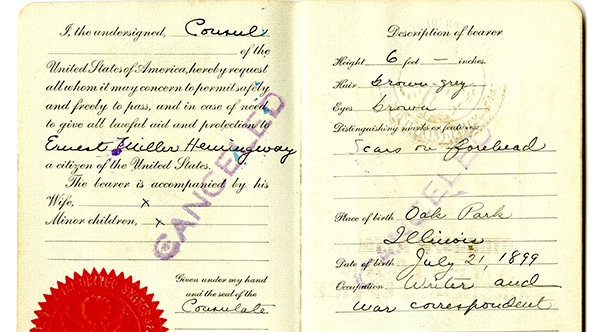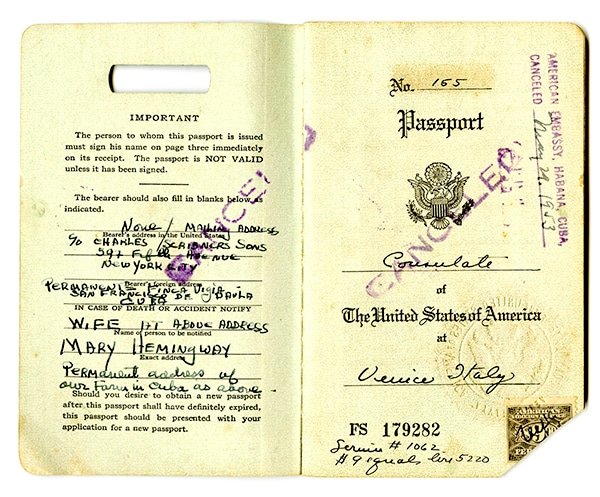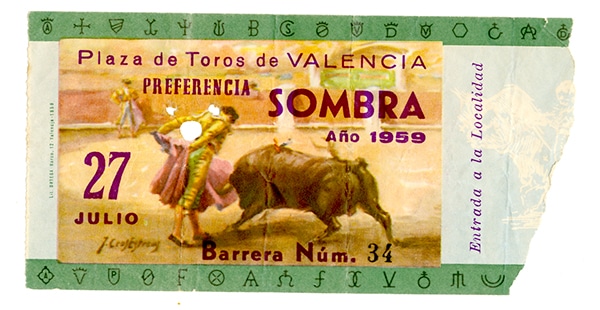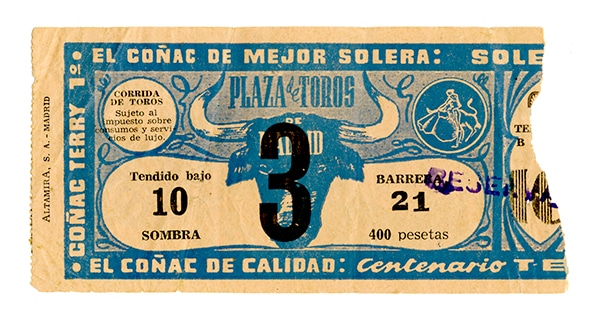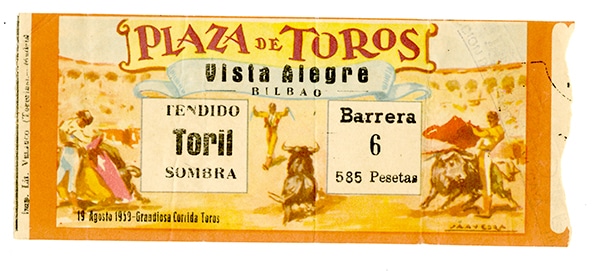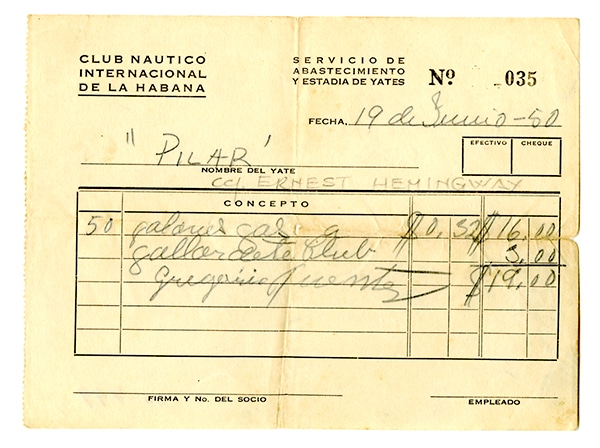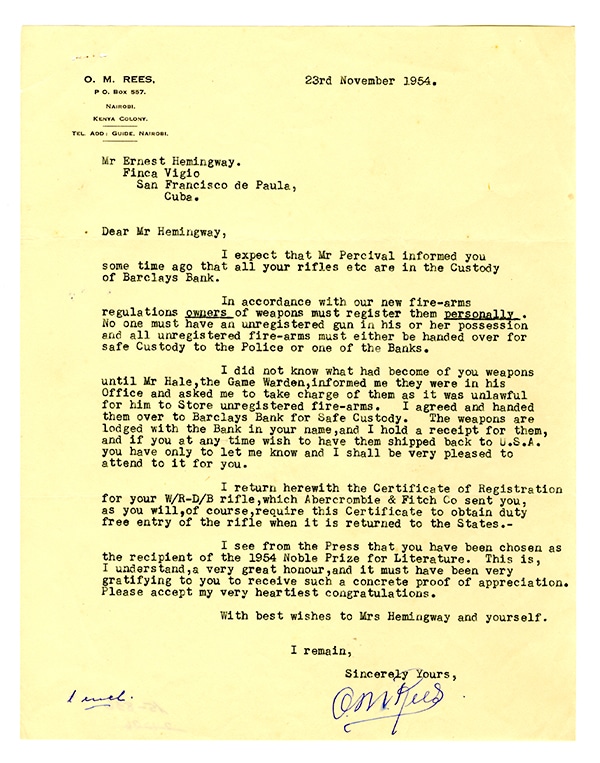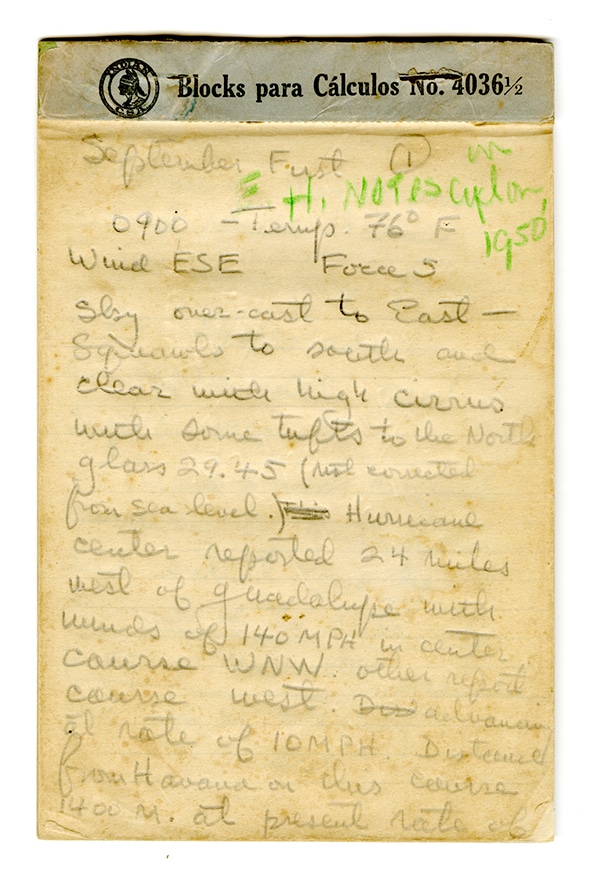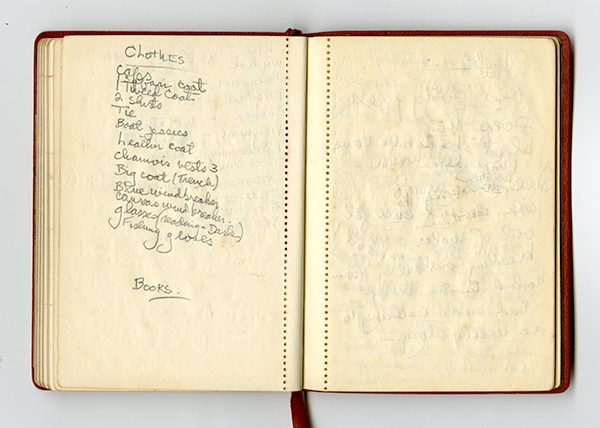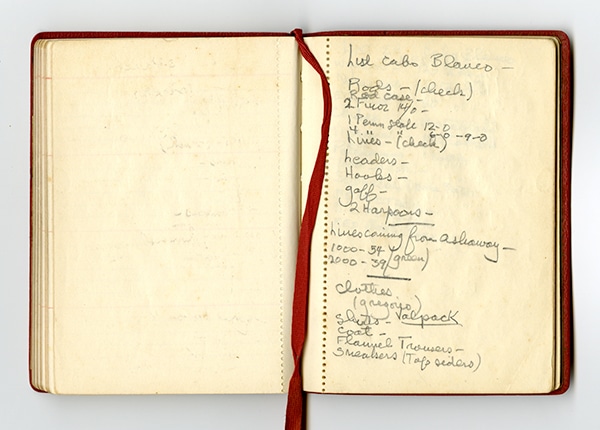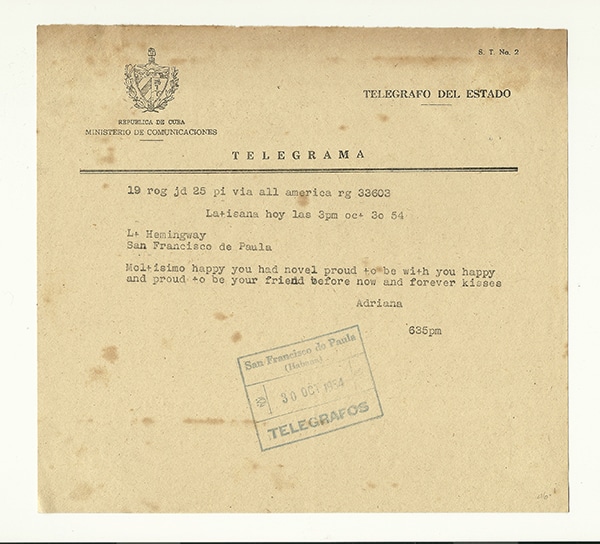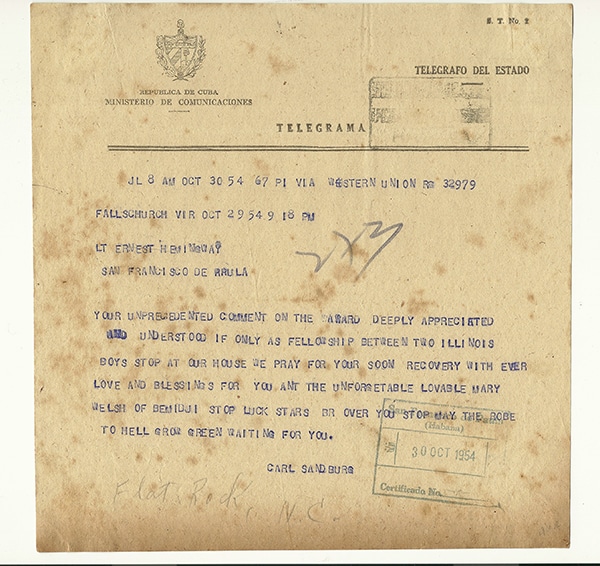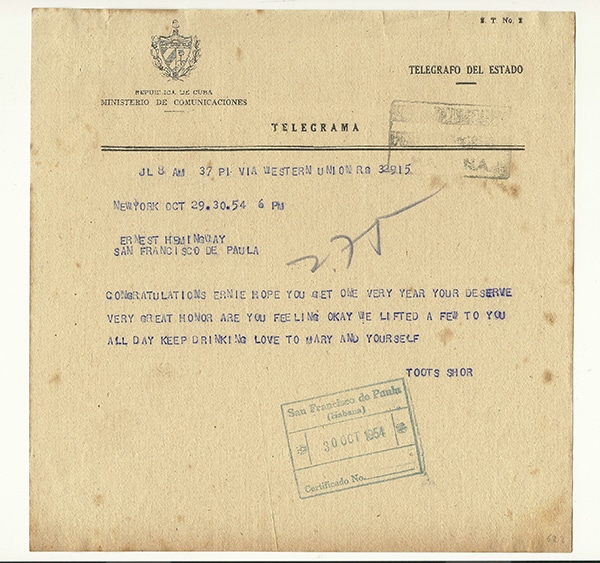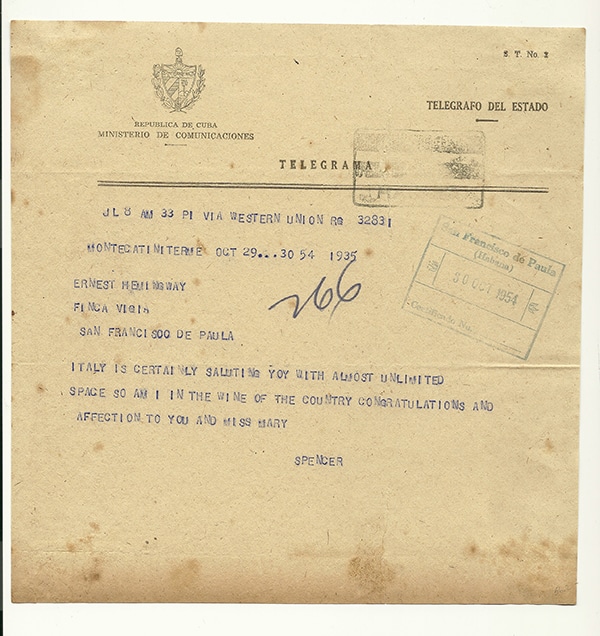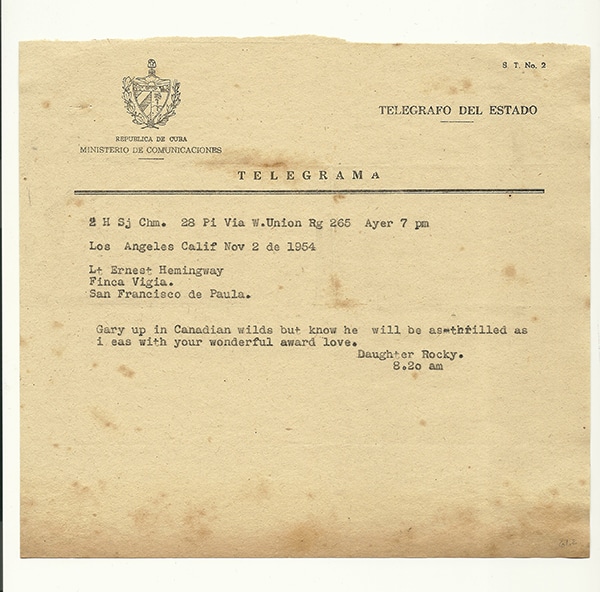The John F. Kennedy Presidential Library and Museum announced that it has made available, 2,500 digital scans of Ernest Hemingway materials housed at Ernest Hemingway’s former Cuban estate, the Finca Vigía. This material, which has never been seen outside of Cuba, includes letters, passports, telegrams, household accounts, bar bills, recipes and a notebook of hurricane observations among other items. It was digitized through the efforts of the U.S. Finca Vigía Foundation under an agreement with the Cuban Council of National Heritage.
It’s a treasure trove of some insight into Hemingway’s life. One piece in particular sticks out: his pan-fried burger recipe.
The BBC reports that Sandra Spanier, general editor of the Hemingway Letters Project, made Papa’s favorite hamburger recipe available in digital form by the JFK Presidential Library.
Some of Hemingway’s ingredients, like India relish and Spice Islands mixtures, might not be located in the local grocery store, but with enough research online or in cookbooks, one could make their very own Mei Yen seasoning. Adding soy sauce to the recipe is something that might come from Hemingway’s past. According to Spanier, one of his favorite restaurants was in Havana’s Chinatown.
Hemingway’s “What to do” section is entertaining on its own. He could even write about cooking a burger and make it meaningful.
Break up the meat with a fork and scatter the garlic, onion and dry seasonings over it, then mix them in the meat with a fork or your fingers. Let the bowl of meat sit out of the icebox for ten or fifteen minutes while you set the table and make the salad. Add the relish, capers, everything else including wine and let the meat sit, quietly marinating, for another ten minutes if possible. Now make four fat, juicy paties with your hands. The patties should be an inch thick, and soft in texture but not runny. Have the oil in your frying-pan hot but not smoking when you drop in the patties and then turn the heat down and fry the burgers about four minutes. Take the pan off the burner and turn the heat high again. Flip the burgers over, put the pan back on the hot fire, then after one minute, turn the heat down again and cook another three minutes. Both sides of the burgers should be crispy brown and the middle pink and juicy.
Hemingway wrote many of his famous works at the Finca Vigía, including For Whom the Bell Tolls and The Old Man and the Sea. The manuscripts published posthumously, A Moveable Feast, Islands in the Stream, The Dangerous Summer, The Garden of Eden, and True at First Light were also written in Cuba where he lived from 1939 to 1960.
After Hemingway’s death in 1961, despite a U.S. ban on travel to Cuba, President Kennedy made arrangements for Hemingway’s widow, Mary, to enter Cuba to claim family documents and belongings. While in Cuba, Mrs. Hemingway met with Fidel Castro, who allowed her to take her husband’s papers and the artwork he collected in exchange for the donation of their Finca Vigía home and its remaining belongings to the Cuban people.
A 1968 exchange of letters between Mary Hemingway and Jacqueline Kennedy Onassis confirmed that the Hemingway papers would find a permanent home at the Kennedy Library. However, thousands of documents remained at Hemingway’s house in the outskirts of Havana. Over the next forty years, the Finca Vigía was operated by the Cuban government. Thousands of photographs, original manuscripts and galleys of his stories and novels, his correspondence and his journals, and a personal library of almost nine thousand volumes – many with his writing in the margins – remained in Cuba but were in danger of deterioration from heat, humidity, pests, mold, and the sheer passage of time.
In 2002 a bi-national collaboration was formed to provide additional resources to preserve these treasures. An agreement was signed in Cuba at the Finca Vigía by former Cuban President Fidel Castro, Sean Hemingway (Hemingway’s grandson), U.S. Congressman James McGovern, and representatives of the Finca Vigía Foundation who continue to assist the Cuban government in the digitization and scanning process.
Check out more from the Ernest Hemingway Collection.
“Papa’s Favorite Hamburger” recipe, with Mary Hemingway’s handwritten notes Courtesy of Ernest Hemingway Papers Collection, Museum Ernest Hemingway, Finca Vigia, San Francisco de Paula, Cuba.
Courtesy of Ernest Hemingway Papers Collection, Museum Ernest Hemingway, Finca Vigia, San Francisco de Paula, Cuba.
Telegram from Dr. Anders Osterling of the Swedish Academy, notifying Ernest Hemingway that he has been awarded the 1954 Nobel Prize for Literature. Courtesy of Ernest Hemingway Papers Collection, Museum Ernest Hemingway, Finca Vigia, San Francisco de Paula, Cuba.
Courtesy of Ernest Hemingway Papers Collection, Museum Ernest Hemingway, Finca Vigia, San Francisco de Paula, Cuba.
Card sent by Secretary of the American Museum of National History Clarence L. Hay to Ernest Hemingway, acknowledging his contribution of an eight-pound swordfish to the museum’s collections. Courtesy of Ernest Hemingway Papers Collection, Museum Ernest Hemingway, Finca Vigia, San Francisco de Paula, Cuba
Courtesy of Ernest Hemingway Papers Collection, Museum Ernest Hemingway, Finca Vigia, San Francisco de Paula, Cuba
Insurance document related to Ernest Hemingway’s 1941 Plymouth Station Wagon. Courtesy of Ernest Hemingway Papers Collection, Museum Ernest Hemingway, Finca Vigia, San Francisco de Paula, Cuba.
Courtesy of Ernest Hemingway Papers Collection, Museum Ernest Hemingway, Finca Vigia, San Francisco de Paula, Cuba.
Ernest Hemingway’s receipt for books purchased at La Bohemia bookstore in Havana, Cuba, 1944. The books include John Hersey’s A Bell for Adano; Alexander Pushkin’s The Queen of Spades; Robert Standish’s Bonin: A Novel; and a “Diccionario militar.” Courtesy of Ernest Hemingway Papers Collection, Museum Ernest Hemingway, Finca Vigia, San Francisco de Paula, Cuba.
Courtesy of Ernest Hemingway Papers Collection, Museum Ernest Hemingway, Finca Vigia, San Francisco de Paula, Cuba.
Invoice for a Buick Super Station Wagon purchased by Ernest Hemingway in Key West, 1959. Courtesy of Ernest Hemingway Papers Collection, Museum Ernest Hemingway, Finca Vigia, San Francisco de Paula, Cuba.
Courtesy of Ernest Hemingway Papers Collection, Museum Ernest Hemingway, Finca Vigia, San Francisco de Paula, Cuba.
Ernest Hemingway’s license to carry arms in Cuba, 1950. Courtesy of Ernest Hemingway Papers Collection, Museum Ernest Hemingway, Finca Vigia, San Francisco de Paula, Cuba.
Courtesy of Ernest Hemingway Papers Collection, Museum Ernest Hemingway, Finca Vigia, San Francisco de Paula, Cuba.
The back of Ernest Hemingway’s 1950 Cuban gun license, listing the weapons covered by the license. Courtesy of Ernest Hemingway Papers Collection, Museum Ernest Hemingway, Finca Vigia, San Francisco de Paula, Cuba.
Courtesy of Ernest Hemingway Papers Collection, Museum Ernest Hemingway, Finca Vigia, San Francisco de Paula, Cuba.
Ernest Hemingway’s Cuban Tarjeta de Turista (tourist card). Courtesy of Ernest Hemingway Papers Collection, Museum Ernest Hemingway, Finca Vigia, San Francisco de Paula, Cuba.
Courtesy of Ernest Hemingway Papers Collection, Museum Ernest Hemingway, Finca Vigia, San Francisco de Paula, Cuba.
A page from Ernest Hemingway’s passport. Courtesy of Ernest Hemingway Papers Collection, Museum Ernest Hemingway, Finca Vigia, San Francisco de Paula, Cuba.
Courtesy of Ernest Hemingway Papers Collection, Museum Ernest Hemingway, Finca Vigia, San Francisco de Paula, Cuba.
Photograph from Ernest Hemingway’s passport. Courtesy of Ernest Hemingway Papers Collection, Museum Ernest Hemingway, Finca Vigia, San Francisco de Paula, Cuba.
Courtesy of Ernest Hemingway Papers Collection, Museum Ernest Hemingway, Finca Vigia, San Francisco de Paula, Cuba.
Pages from Ernest Hemingway’s passports. Courtesy of Ernest Hemingway Papers Collection, Museum Ernest Hemingway, Finca Vigia, San Francisco de Paula, Cuba.
Courtesy of Ernest Hemingway Papers Collection, Museum Ernest Hemingway, Finca Vigia, San Francisco de Paula, Cuba.
Pages from Ernest Hemingway’s passports. Courtesy of Ernest Hemingway Papers Collection, Museum Ernest Hemingway, Finca Vigia, San Francisco de Paula, Cuba
Courtesy of Ernest Hemingway Papers Collection, Museum Ernest Hemingway, Finca Vigia, San Francisco de Paula, Cuba
Bullfighting ticket stubs, attended by Ernest Hemingway Courtesy of Ernest Hemingway Papers Collection, Museum Ernest Hemingway, Finca Vigia, San Francisco de Paula, Cuba.
Courtesy of Ernest Hemingway Papers Collection, Museum Ernest Hemingway, Finca Vigia, San Francisco de Paula, Cuba.
Bullfighting ticket stubs, attended by Ernest Hemingway Courtesy of Ernest Hemingway Papers Collection, Museum Ernest Hemingway, Finca Vigia, San Francisco de Paula, Cuba.
Courtesy of Ernest Hemingway Papers Collection, Museum Ernest Hemingway, Finca Vigia, San Francisco de Paula, Cuba.
Bullfighting ticket stubs, attended by Ernest Hemingway Courtesy of Ernest Hemingway Papers Collection, Museum Ernest Hemingway, Finca Vigia, San Francisco de Paula, Cuba.
Courtesy of Ernest Hemingway Papers Collection, Museum Ernest Hemingway, Finca Vigia, San Francisco de Paula, Cuba.
Gas bill for Ernest Hemingway’s yacht Pilar, from the International Nautical Club of Havana. Courtesy of Ernest Hemingway Papers Collection, Museum Ernest Hemingway, Finca Vigia, San Francisco de Paula, Cuba.
Courtesy of Ernest Hemingway Papers Collection, Museum Ernest Hemingway, Finca Vigia, San Francisco de Paula, Cuba.
Letter from Kenya safari guide O.M. Rees to Ernest Hemingway, informing Ernest Hemingway that his hunting rifles are in the custody of Barclays Bank in Kenya. Rees also congratulates EH on the Nobel Prize. Courtesy of Ernest Hemingway Papers Collection, Museum Ernest Hemingway, Finca Vigia, San Francisco de Paula, Cuba.
Courtesy of Ernest Hemingway Papers Collection, Museum Ernest Hemingway, Finca Vigia, San Francisco de Paula, Cuba.
Excerpts from Hemingway’s log related to a fall 1950 hurricane that hit Cuba. Courtesy of Ernest Hemingway Papers Collection, Museum Ernest Hemingway, Finca Vigia, San Francisco de Paula, Cuba.
Courtesy of Ernest Hemingway Papers Collection, Museum Ernest Hemingway, Finca Vigia, San Francisco de Paula, Cuba.
Excerpts from Hemingway’s log related to a fall 1950 hurricane that hit Cuba. Courtesy of Ernest Hemingway Papers Collection, Museum Ernest Hemingway, Finca Vigia, San Francisco de Paula, Cuba.
Courtesy of Ernest Hemingway Papers Collection, Museum Ernest Hemingway, Finca Vigia, San Francisco de Paula, Cuba.
Packing list for a trip to Cabo Blanco, Peru; this list includes clothing. Courtesy of Ernest Hemingway Papers Collection, Museum Ernest Hemingway, Finca Vigia, San Francisco de Paula, Cuba.
Courtesy of Ernest Hemingway Papers Collection, Museum Ernest Hemingway, Finca Vigia, San Francisco de Paula, Cuba.
Packing list for a trip to Cabo Blanco, Peru, famous for the Cabo Blanco Fishing Club; this list includes mostly fishing equipment. Ernest Hemingway traveled to Cabo Blanco during the filming of The Old Man and the Sea. Courtesy of Ernest Hemingway Papers Collection, Museum Ernest Hemingway, Finca Vigia, San Francisco de Paula, Cuba.
Courtesy of Ernest Hemingway Papers Collection, Museum Ernest Hemingway, Finca Vigia, San Francisco de Paula, Cuba.
Congratulatory telegram from Lillian Ross sent to Ernest Hemingway after the announcement that he had won the 1954 Nobel Prize for Literature. Courtesy of Ernest Hemingway Papers Collection, Museum Ernest Hemingway, Finca Vigia, San Francisco de Paula, Cuba.
Courtesy of Ernest Hemingway Papers Collection, Museum Ernest Hemingway, Finca Vigia, San Francisco de Paula, Cuba.
Congratulatory telegram from John Huston sent to Ernest Hemingway after the announcement that he had won the 1954 Nobel Prize for Literature. Courtesy of Ernest Hemingway Papers Collection, Museum Ernest Hemingway, Finca Vigia, San Francisco de Paula, Cuba.
Courtesy of Ernest Hemingway Papers Collection, Museum Ernest Hemingway, Finca Vigia, San Francisco de Paula, Cuba.
Congratulatory telegram from Adriana Ivancich sent to Ernest Hemingway after the announcement that he had won the 1954 Nobel Prize for Literature. Courtesy of Ernest Hemingway Papers Collection, Museum Ernest Hemingway, Finca Vigia, San Francisco de Paula, Cuba.
Courtesy of Ernest Hemingway Papers Collection, Museum Ernest Hemingway, Finca Vigia, San Francisco de Paula, Cuba.
Congratulatory telegram from Carl Sandburg sent to Ernest Hemingway after the announcement that he had won the 1954 Nobel Prize for Literature. Courtesy of Ernest Hemingway Papers Collection, Museum Ernest Hemingway, Finca Vigia, San Francisco de Paula, Cuba
Courtesy of Ernest Hemingway Papers Collection, Museum Ernest Hemingway, Finca Vigia, San Francisco de Paula, Cuba
Congratulatory telegram from Toots Shor sent to Ernest Hemingway after the announcement that he had won the 1954 Nobel Prize for Literature. Courtesy of Ernest Hemingway Papers Collection, Museum Ernest Hemingway, Finca Vigia, San Francisco de Paula, Cuba.
Courtesy of Ernest Hemingway Papers Collection, Museum Ernest Hemingway, Finca Vigia, San Francisco de Paula, Cuba.
Congratulatory telegram from Spencer Tracy sent to Ernest Hemingway after the announcement that he had won the 1954 Nobel Prize for Literature. Courtesy of Ernest Hemingway Papers Collection, Museum Ernest Hemingway, Finca Vigia, San Francisco de Paula, Cuba.
Congratulatory telegram from Gary Cooper’s wife sent to Ernest Hemingway after the announcement that he had won the 1954 Nobel Prize for Literature. Courtesy of Ernest Hemingway Papers Collection, Museum Ernest Hemingway, Finca Vigia, San Francisco de Paula, Cuba.
Courtesy of Ernest Hemingway Papers Collection, Museum Ernest Hemingway, Finca Vigia, San Francisco de Paula, Cuba.
